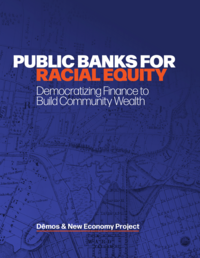The racial wealth divide is vast and growing. Black households today hold just $15 in wealth for every $100 held by white households.
The disparities are rooted in centuries of systemic injustice, from slavery and land grabs to Jim Crow segregation, from lending and employment discrimination to how we structure housing and tax policies. These factors continue to concentrate wealth at the top. Commercial banks have played a major role in driving and perpetuating racial wealth inequality. For generations, banks have systematically deprived Black and brown communities of affordable loans and financial services needed to purchase homes, start businesses, and build wealth.
At the same time, the federal government confers extraordinary backing and support to banks—from low- and no-interest loans to deposit insurance and even bailouts. Many state laws mandate that governments deposit public funds exclusively in commercial banks, giving Wall Street a virtual monopoly to hold more than four trillion dollars in state and local deposits each year. Banks leverage these deposits to finance lucrative but destructive industries, such as fossil fuels and speculative real estate development, that disproportionately harm Black and brown communities and undermine the public good.
Through public banks, cities and states can responsibly steward public deposits and leverage them to expand fair banking access
Growing support for public banking presents an opportunity for a transformative shift. Public banks — created by state or local governments and chartered to serve the public interest — can manage public deposits and partner with local lenders to make loans and investments in underserved communities and sectors. Through public banks, cities and states can responsibly steward public deposits and leverage them to expand fair banking access, build wealth in historically marginalized communities, and advance other policy objectives.
More than 900 public banks exist around the world, collectively controlling $55 trillion in assets. In the U.S., the Bank of North Dakota has operated for over a century, with powerful results as the most diverse and resilient banking system in the U.S. According to the Public Banking Institute, more than half of U.S. states and many cities have introduced or enacted public banking proposals since 2010 — spurred by the urgent need for investments in affordable housing, renewable energy, and other pressing needs.
In this report, we discuss how stark racial disparities have long pervaded our financial services system, fueling and entrenching inequality. We explore public banks as an alternative to catalyze transformative loans and investments, at scale, to reduce the racial wealth divide and foster economic cooperation. Our analysis is informed by interviews with community development and public banking professionals, advocates, and experts from the U.S. and Canada. We analyze nine U.S. state and local public banking proposals, as well as the federal Public Banking Act and several public banks in operation today, to identify governance, operations, and transparency frameworks best positioned to advance racial and social equity outcomes. We offer recommendations for policymakers and advocates seeking to advance public banks as a solution to systemic inequality.
Download the full PDF
Key Findings
- Commercial banks continue to fuel the racial wealth divide, excluding and extracting wealth from low-income and Black and brown communities.
- Public banks, if intentionally designed, offer a transformative alternative — capable of scaling investment in historically excluded communities to build wealth and help close the racial wealth divide.
- Public banks can help catalyze community wealth building by supporting shared ownership of land, housing, and businesses; promoting locally rooted finance; and aligning public money with equity goals.
- To be effective in addressing racial wealth inequality, public banks must be built on three key pillars:
- inclusive, accountable, and independent governance with a clear public-purpose mission rooted in social, economic, and racial justice;
- mission-driven lending in partnership with community development lenders that serve historically marginalized communities; and
- robust capitalization and appropriate regulatory frameworks enabling public banks to operate at a scale that can meaningfully reshape capital flows toward historically excluded communities.
Across the country, public banking proposals are advancing a partnership model —one in which public banks work alongside local lenders, especially nonprofit community development financial institutions (CDFIs) and credit unions. By providing liquidity for loans, credit enhancements, and other support, public banks can help CDFIs and other mission-driven lenders deepen their impact in historically redlined communities of color.
Download the full PDF for recommendations for policymakers and advocates seeking to advance public banks as a solution to systemic inequality
